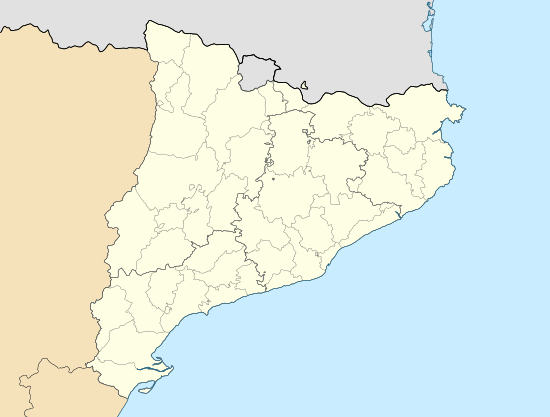Puigcerdà
| Puigcerdà | |||
|---|---|---|---|
| Municipality | |||
|
Casa de la Vila, the city hall | |||
| |||
 Puigcerdà Location in Catalonia  Puigcerdà Puigcerdà (Spain) | |||
| Coordinates: 42°25′54″N 1°55′42″E / 42.43167°N 1.92833°E | |||
| Country |
| ||
| Autonomous community |
| ||
| Province | Girona | ||
| Comarca | Baixa Cerdanya | ||
| Government | |||
| • Mayor | Albert Piñeira Brosel (2015)[1] (CiU) | ||
| Area[2] | |||
| • Total | 18.9 km2 (7.3 sq mi) | ||
| Elevation | 1,202 m (3,944 ft) | ||
| Population (2014)[1] | |||
| • Total | 8,761 | ||
| • Density | 460/km2 (1,200/sq mi) | ||
| Demonym(s) | Puigcerdanenc | ||
| Time zone | UTC+1 (CET) | ||
| • Summer (DST) | UTC+2 (CEST) | ||
| Climate | Cfb | ||
| Website |
puigcerda | ||
Puigcerdà (Catalan pronunciation: [ˌputʃsəɾˈða]; Spanish: Puigcerdá) is the capital of the Catalan comarca of Cerdanya, in the province of Girona, Catalonia, northern Spain, near the Segre River and on the border with France (it abuts directly onto the French town of Bourg-Madame).
History
Puigcerdà is located near the site of a Ceretani settlement, which was incorporated into Roman territory. The Roman town was named Julia Libyca.
Puigcerdà was founded in 1178 by King Alfonso I of Aragon, Count of Barcelona. In 1178 Puigcerdà replaced Hix as the capital of Cerdanya. Hix is now a village in the commune of Bourg-Madame, in the French part of Cerdagne.
Puigcerdà was unique during the Spanish Civil War in having a democratically elected Anarchist council.
The Portet-Saint-Simon–Puigcerdà railway was opened in 1929, crossing the Pyrenees to France.
Main sights
- Puigcerdà Pool
- Torre del Campanar (12th century). It is the last remain of a parish church destroyed in 1936
- Romanesque church of Sant Tomàs de Ventajola, known from 958
- Romanesque church of Sant Andreu Vilallobent, dating to the 10th century and later restored
- Convent of St. Dominic, founded in 1291 and finished in the 15th century
- Old Hospital (1190), in Romanesque-Gothic style
Notable people
- Pere Borrell del Caso (1835-1910), painter
- Gemma Arró Ribot (born 1980), ski mountaineer
- José Antonio Hermida (born 1978), World Champion Cross Country Mountain bike 2010
References
- 1 2 "Ajuntament de Puigcerdà". Generalitat of Catalonia. Retrieved 2015-11-13.
- ↑ "El municipi en xifres: Puigcerdà". Statistical Institute of Catalonia. Retrieved 2015-11-23.
External links
| Wikimedia Commons has media related to Puigcerdà. |
- Government data pages (in Catalan)

